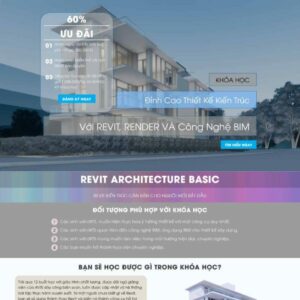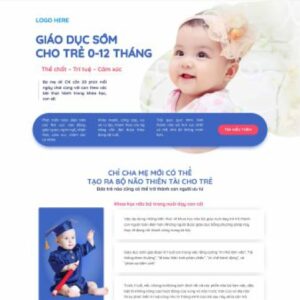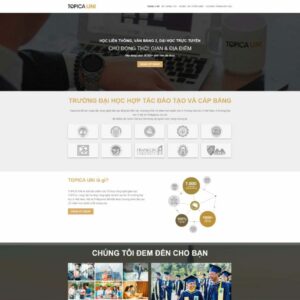
WordPress landing page theme for marketing courses, suitable for selling courses, services, and businesses, optimized for effective customer outreach.
The WordPress Training 2 theme helps you create an attractive training website, attracting students with categories like: Course Sales, Marketing, Services, and Business.
Course 3 is the perfect WordPress theme for online education, combining beautiful design and powerful features to effectively sell courses.
WordPress landing page theme for courses, optimized for effective course sales. Beautiful design, user-friendly, enhancing the learning experience.
Discover the perfect WordPress landing page theme for courses, making it easy to sell courses and attract students with a professional design.
| theme-wordpress-landing-page-course |
The WordPress Edu 11 theme is professional for education, ideal for selling courses and creating impressive landing pages, enhancing the user experience.
WordPress landing page theme for children's courses, designed to sell courses effectively, attract customers, and increase your revenue.
Explore the modern WordPress theme for kids' interior design, featuring a unique design for the course sales category, enhancing user experience and optimizing SEO.
Discover a professional health course landing page template, effective for advertising, helping you attract students and increase revenue.
Discover the WordPress Course Theme 4, perfect for selling courses, designing landing pages, and effectively managing course categories.
Explore the perfect WordPress theme for beauty courses with categories: Course Sales, Business, Study Abroad, Landing Page, Cosmetics, and Spa Aesthetics.
The professional WordPress theme for Bitcoin classes is designed for selling courses, businesses, and study abroad, featuring an impressive landing page and effective SEO optimization.
1. Why Is It Necessary to Design a Professional Online Course Website?
In the digital age, having a professional online course website is a crucial step for educational businesses to effectively and quickly reach students. An online course website is not just a place to showcase training programs; it also serves as a tool for students to easily learn about and enroll in courses. An SEO-friendly course website enhances visibility on search engines, creating a positive impression and reputation in the field of online education.
2. Important Features of an Online Course Website
To provide the best learning experience, an online course website needs to integrate modern and user-friendly features.
The website should have an intuitive interface that organizes information about courses, instructors, and lecture content clearly. High-quality images and videos help convey content in a lively way, engaging students.
2.1. User-Friendly Interface, Optimizing Student Experience
The interface should be designed to be simple and intuitive, making it easy for students to search for suitable courses. Soft, harmonious colors combined with a clear layout will create a comfortable learning environment. Prominent call-to-action (CTA) buttons like “Enroll Now” and “View Course Details” should be strategically placed to encourage students.
2.2. Diverse and Detailed Course Categories
Course categories should be classified by fields such as Business, Marketing, Languages, Soft Skills, etc. Each course should have a detailed description of content, duration, instructor, and tuition fees. Clear information helps students easily choose courses that fit their needs and learning goals.
2.3. Online Payment and Enrollment Features
Integrating online payment and enrollment features allows students to quickly complete their registration. The system should support various payment methods such as credit cards, e-wallets, and bank transfers. Additionally, an automated system for managing students and sending course information via email enhances professionalism.
3. SEO-Friendly Online Course Website Design Process
Designing an SEO-friendly online course website is a key factor in effectively reaching students, increasing conversion rates, and expanding the online education market.
3.1. Conceptualizing the Interface
Design a simple yet modern interface that highlights courses and training programs. The layout should be organized with visible “Enroll Now” and “View Course” buttons. The colors and images used should be appropriate for the education sector to create a professional and trustworthy feel.
3.2. Building Quality Content
Content on the website should focus on detailed introductions to courses, training programs, the teaching team, and the benefits of participation. Naturally incorporate relevant keywords such as “online course website design,” “online learning,” and “online courses” to optimize for SEO.
3.3. Optimizing On-page SEO
Optimize important SEO elements such as title tags, meta descriptions, headings, URLs, and ALT tags for images. Create internal links between course pages and categories to enhance connectivity and help students easily find information.
4. Benefits of Having an SEO-Friendly Online Course Website
Owning an SEO-friendly online course website offers many advantages for businesses in terms of operations and brand development in education.
- Reaching Potential Students: An SEO-friendly website helps businesses appear on the first page of search results, attracting a large number of potential students.
- Optimizing Course Enrollment Process: The online payment and registration system enables students to quickly complete the enrollment process, optimizing student management.
- Enhancing Brand Reputation: A professional website providing detailed information about courses and instructors helps build trust with students and enhance the business’s credibility.
- Cost Savings on Advertising: An SEO-friendly website naturally attracts students, reducing advertising costs while increasing business effectiveness.
5. Trends in Modern Online Course Website Design
Current trends in online course website design focus on optimizing the student experience and creating convenience in the online learning process.
5.1. Minimalist Design, Focusing on Courses
A minimalist design with a clear layout focuses on showcasing prominent courses. High-quality images and videos that introduce courses should be used to create an impression and attract students.
5.2. Integration of Course Introduction Videos
Videos introducing courses, instructors, and benefits of participation help students better understand the program’s content. Videos provide a realistic, lively experience that can motivate students to enroll.
5.3. Mobile Optimization
The website should be designed responsively, compatible with all devices such as computers, phones, and tablets, so that students can access and enroll in courses anytime, anywhere.
6. Choosing a Reputable Online Course Website Design Company
To create a professional online course website, businesses need to choose a reputable design company with experience in educational website design. This company should provide comprehensive design, programming, and SEO optimization services, ensuring the website operates effectively, attracts students, and enhances the learning experience.
Conclusion
Designing an SEO-friendly online course website is an optimal solution to help businesses reach students, effectively promote courses, and increase sales. Invest in designing your online course website today to grow in the online education market and establish your brand’s position in this field.
Related Keywords:
- Online course website design
- Online education website design
- Online course website
- Online training website design services











